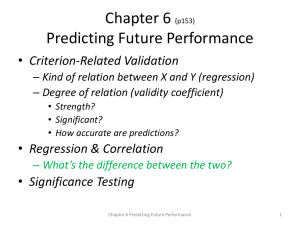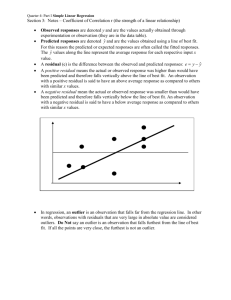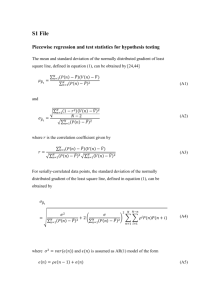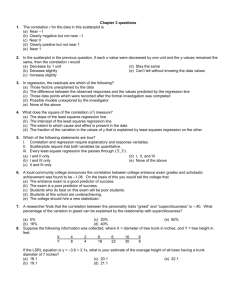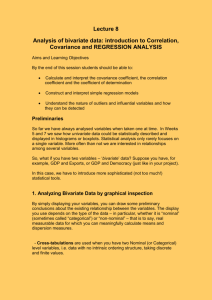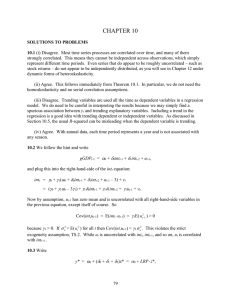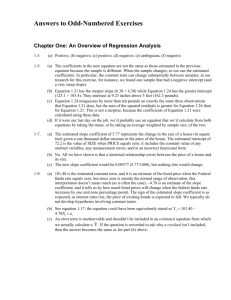samples equation
advertisement
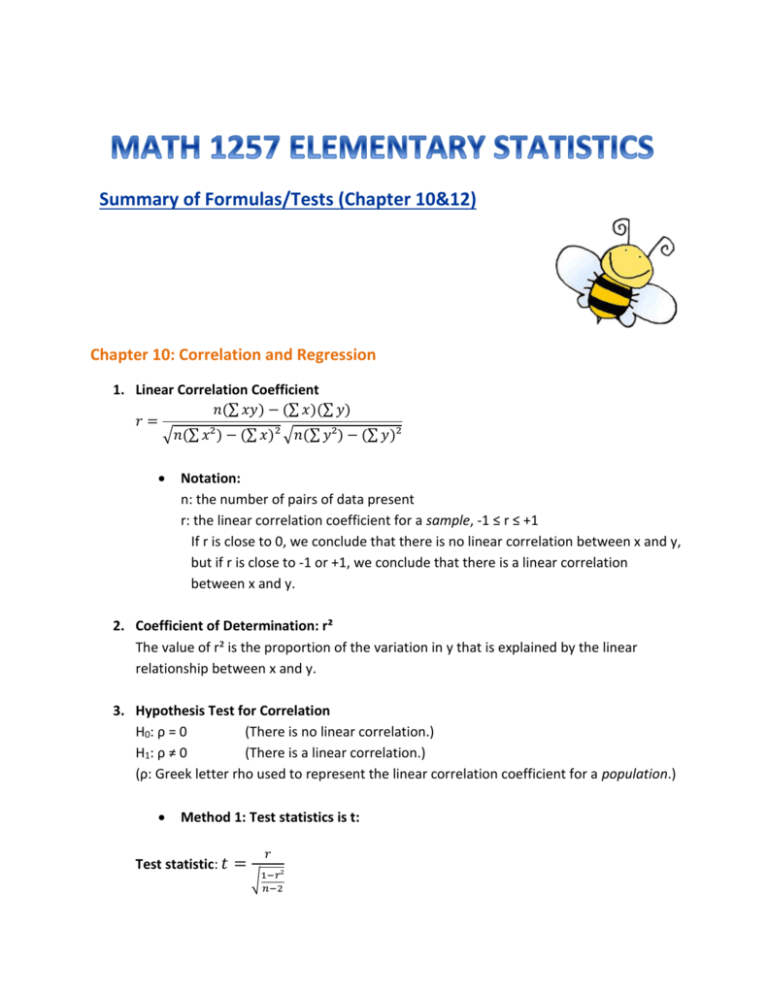
Summary of Formulas/Tests (Chapter 10&12) Chapter 10: Correlation and Regression 1. Linear Correlation Coefficient 𝑛(∑ 𝑥𝑦) − (∑ 𝑥)(∑ 𝑦) 𝑟= √𝑛(∑ 𝑥²) − (∑ 𝑥)² √𝑛(∑ 𝑦²) − (∑ 𝑦)² Notation: n: the number of pairs of data present r: the linear correlation coefficient for a sample, -1 ≤ r ≤ +1 If r is close to 0, we conclude that there is no linear correlation between x and y, but if r is close to -1 or +1, we conclude that there is a linear correlation between x and y. 2. Coefficient of Determination: r² The value of r² is the proportion of the variation in y that is explained by the linear relationship between x and y. 3. Hypothesis Test for Correlation H0: ρ = 0 (There is no linear correlation.) H1: ρ ≠ 0 (There is a linear correlation.) (ρ: Greek letter rho used to represent the linear correlation coefficient for a population.) Method 1: Test statistics is t: Test statistic: 𝑡 = 𝑟 √1−𝑟² 𝑛−2 Critical values: t distribution (Table A-3 with df = n – 2) Method 2: test statistic is r Test statistic: 𝑟 = 𝑛(∑ 𝑥𝑦)−(∑ 𝑥)(∑ 𝑦) √𝑛(∑ 𝑥²)−(∑ 𝑥)²√𝑛(∑ 𝑦²)−(∑ 𝑦)² Critical value: critical values of the person correlation coefficient r (Table A-6) 4. Regression Equation Notations for regression equation Population parameter y-intercept of regression equation β0 Slope of regression equation β1 Equation of the regression line Y = β0 + β1x b1= Sample statistic b0 b1 𝑦̂ = b0 + b1x 𝑛(∑ 𝑥𝑦)−(∑ 𝑥)(∑ 𝑦) 𝑛(∑ 𝑥²)−(∑ 𝑥)² b0= 𝑦 − b1𝑥 or 𝑏0 = (∑ 𝑦)(∑ 𝑥 2 )−(∑ 𝑥)(∑ 𝑥𝑦) 𝑛((∑ 𝑥 2 )−(∑ 𝑥)² 𝑦̂ = b0 + b1x 5. 6. 7. 8. Residual = observed y – predicted y = y - 𝑦̂ Total Deviation = y - 𝑦, total variation = ∑(𝑦 − 𝑦)² Explained Deviation = y - 𝑦̂ − 𝑦, explained variation = ∑( 𝑦̂ − 𝑦)² Unexplained Deviation = 𝑦 − 𝑦̂, unexplained variation = ∑(𝑦 − 𝑦̂)² 9. Coefficient of Determination: 𝑟² = 10. Standard Error of Estimate: se= √ 𝑒𝑥𝑝𝑙𝑎𝑖𝑛𝑒𝑑 𝑣𝑎𝑟𝑖𝑎𝑡𝑖𝑜𝑛 𝑡𝑜𝑡𝑎𝑙 𝑣𝑎𝑟𝑖𝑎𝑡𝑖𝑜𝑛 ∑(𝑦−𝑦̂)² 𝑛−2 or se= √ 1 𝑛 + − 𝑦)² ∑ 𝑦²−𝑏0 ∑ 𝑦−𝑏1 ∑ 𝑥𝑦 11. Prediction Interval for an Individual y Margin of error: E = tα/2Se√1 + ∑(𝑦̂−𝑦)² = ∑(y 𝑛(𝑥0 −𝑥)² 𝑛(∑ 𝑥²)−(∑ 𝑥)² Prediction interval: 𝑦̂ − 𝐸 < 𝑦 < 𝑦̂ + 𝐸 X0: given value of x tα/2: t distribution (Table A-3 with df = n-2) 12. Multiple Regression Multiple regression equation: 𝑦̂ = b0 + b1x1 + b2x2 + ⋯ + bkxk 𝑛−2 Adjusted coefficient of determination: 𝑅² = 1 − (𝑛−1) [𝑛−(𝑘+1)] (1 − 𝑅2 ) n: sample size k: number of predictor (x) variables Chapter 12: Analysis of Variance 1. One-Way ANOVA with Equal Sample Sizes n H0: µ1 = µ2 = µ3 = ... H1: At least one of the means is different from the others. Test statistic: 𝐹 = 𝑣𝑎𝑟𝑖𝑎𝑛𝑐𝑒 𝑏𝑒𝑡𝑤𝑒𝑒𝑛 𝑠𝑎𝑚𝑝𝑙𝑒𝑠 𝑣𝑎𝑟𝑖𝑎𝑛𝑐𝑒 𝑤𝑖𝑡ℎ𝑖𝑛 𝑠𝑎𝑚𝑝𝑙𝑒𝑠 = 𝑛𝑠𝑥2 𝑠𝑝2 = 𝑛𝑠𝑥2 2 2 𝑠2 1 +𝑠2 +⋯+𝑠𝑘 𝑘 Critical values: F distribution (Table A-5 with numerator df = k – 1 and denominator df = k (n - ), k = number of samples and n = sample size) 2. One-Way ANOVA with Unequal Sample Sizes H0: µ1 = µ2 = µ3 = ... H1: At least one of the means is different from the others. Test statistic: 𝐹= 𝑣𝑎𝑟𝑖𝑎𝑛𝑐𝑒 𝑏𝑒𝑡𝑤𝑒𝑒𝑛 𝑠𝑎𝑚𝑝𝑙𝑒𝑠 𝑣𝑎𝑟𝑖𝑎𝑛𝑐𝑒 𝑤𝑖𝑡ℎ𝑖𝑛 𝑠𝑎𝑚𝑝𝑙𝑒𝑠 = ∑ 𝑛𝑖 (𝑥𝑖−𝑥 ̿)² ] 𝑘−1 ∑(𝑛 −1)𝑠2 [ ∑(𝑛𝑖 −1)𝑖 ] 𝑖 [ = 𝑀𝑆 (𝑡𝑟𝑒𝑎𝑡𝑚𝑒𝑛𝑡) 𝑀𝑆 (𝑒𝑟𝑟𝑜𝑟) Notation: 𝑥̿ : mean of all sample values combined 𝑘: number of population means being compared 𝑛𝑖 : number of values in the ith sample 𝑥𝑖 : mean of values in the ith sample 𝑠𝑖2 : variance of values in the ith sample Critical values: F distribution (Table A-5 with numerator df = k – 1 and denominator df = N – k with k = number of samples and N = total number of values in all samples combined) 3. Two-Way ANOVA H0: There are no effects from the row factor (that is, the row means are equal). H1: There are no effects from the column factor (that is, the column means are equal). Step 1. Interaction Effect Test for an interaction between the two factors using 𝐹 = 𝑀𝑆 (𝑖𝑛𝑡𝑒𝑟𝑎𝑐𝑡𝑖𝑜𝑛) 𝑀𝑆(𝑒𝑟𝑟𝑜𝑟) Step 2. Row/Column Effect Is there an effect due to interaction between the two factors? Yes (Reject H0 of no interaction effect.). Stop. Don’t consider the effects of either factor without considering the effects of the other. No (Fail to reject H0) of no interaction effect.). Test for effect from row factor using 𝐹 = 𝑀𝑆 (𝑟𝑜𝑤 𝑓𝑎𝑐𝑡𝑜𝑟) 𝑀𝑆(𝑒𝑟𝑟𝑜𝑟) Interpretation: Compare P-value with significance level. If the P-value is less than or equal to the significance level, reject the null hypothesis of no effects from the row factor. If the P-value is greater than the significance level, fail to reject the null hypothesis of no effects from the row factor. Test for effect from column factor using 𝐹 = 𝑀𝑆 (𝑐𝑜𝑙𝑢𝑚𝑛 𝑓𝑎𝑐𝑡𝑜𝑟) 𝑀𝑆(𝑒𝑟𝑟𝑜𝑟) Interpretation: Compare P-value with significance level. If the P-value is less than or equal to the significance level, reject the null hypothesis of no effects from the column factor. If the P-value is greater than the significance level, fail to reject the null hypothesis of no effects from the column factor.
